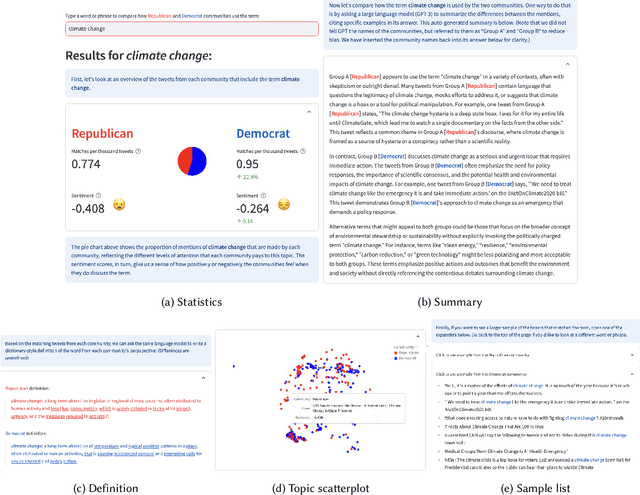Andrew Heyward
AudienceView: AI-Assisted Interpretation of Audience Feedback in Journalism
Jul 17, 2024

Abstract:Understanding and making use of audience feedback is important but difficult for journalists, who now face an impractically large volume of audience comments online. We introduce AudienceView, an online tool to help journalists categorize and interpret this feedback by leveraging large language models (LLMs). AudienceView identifies themes and topics, connects them back to specific comments, provides ways to visualize the sentiment and distribution of the comments, and helps users develop ideas for subsequent reporting projects. We consider how such tools can be useful in a journalist's workflow, and emphasize the importance of contextual awareness and human judgment.
Bridging Dictionary: AI-Generated Dictionary of Partisan Language Use
Jul 12, 2024

Abstract:Words often carry different meanings for people from diverse backgrounds. Today's era of social polarization demands that we choose words carefully to prevent miscommunication, especially in political communication and journalism. To address this issue, we introduce the Bridging Dictionary, an interactive tool designed to illuminate how words are perceived by people with different political views. The Bridging Dictionary includes a static, printable document featuring 796 terms with summaries generated by a large language model. These summaries highlight how the terms are used distinctively by Republicans and Democrats. Additionally, the Bridging Dictionary offers an interactive interface that lets users explore selected words, visualizing their frequency, sentiment, summaries, and examples across political divides. We present a use case for journalists and emphasize the importance of human agency and trust in further enhancing this tool. The deployed version of Bridging Dictionary is available at https://dictionary.ccc-mit.org/.
 Add to Chrome
Add to Chrome Add to Firefox
Add to Firefox Add to Edge
Add to Edge